#trying to draw them biblically accurate more often
Text
oh to have a big dangerous creepy animatronic wrapped around your finger,, sigh....


#trying to draw them biblically accurate more often#i WANT THEM UGH#i need to be lobotomized#fnaf sun#fnaf self insert#fnaf moon#moon fnaf#sun fnaf#fnaf moondrop#fnaf sundrop#fnaf dca#fnaf daycare attendant#moondrop#sundrop#fnaf self ship#kirbsart#fnaf f/o#fnaf s/i
2K notes
·
View notes
Text
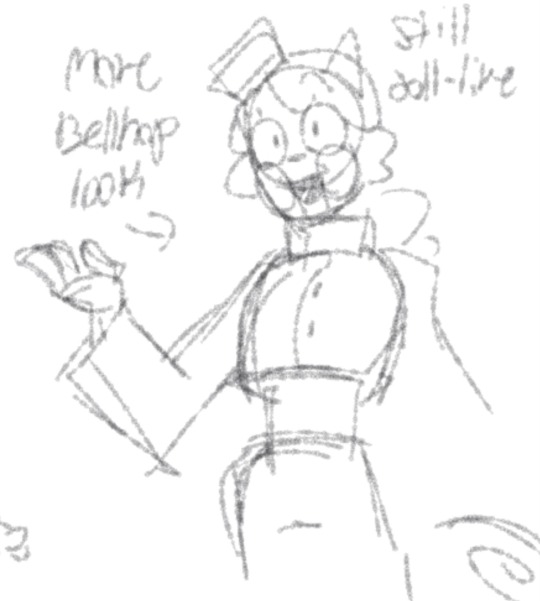
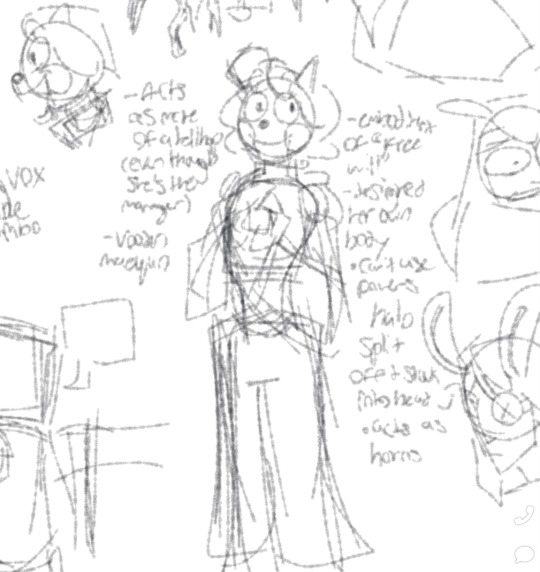

Finally am confident enough to post my redesign of Charlie. Buckle up cause it’s a lot!
Kept her simple since I think her original design is kinda alright, but went with the doll aesthetic more.
Made her design simple enough for it to stand out in most any environment within Hell. Should probably have made a colored version for her, but I'm keeping the white and pink from her original design, but making her outfit yellow to compliment the reds of Hell and the blues of Heaven.
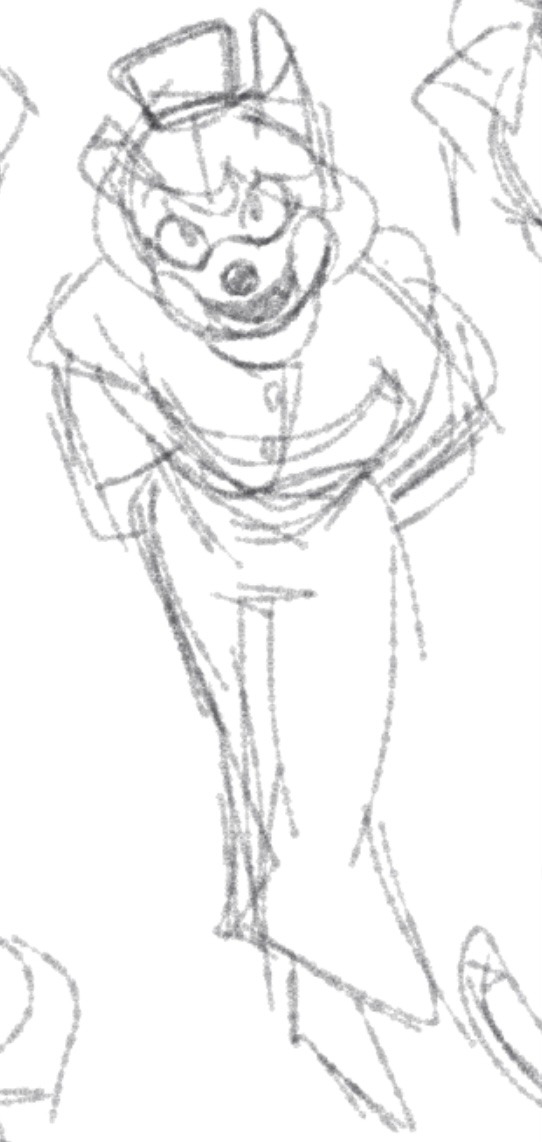
Here’s the newest design although I'm still fiddling around with different variations for the marks on her face, shown later in this post. Might lean towards stop motion look with how the mouths of the characters are always a separate segment from the face.
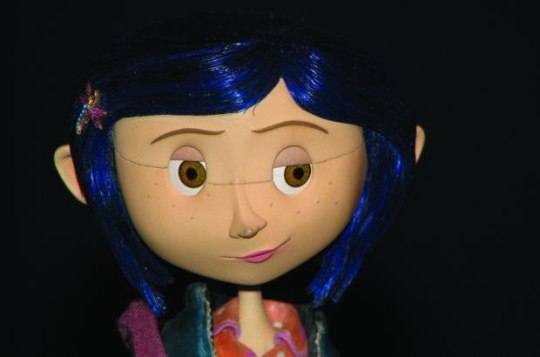

Eventually she goes from bellhop to more of a concierge roll as she gains more confidence in running the hotel, and eventually becomes the defacto ruler of Purgatory.
More on that later.

Also lil Lucifer resign too. Might make a whole post about him, but the basics are that I decided to go more “biblically accurate” angel for him.
He made Charlie's body, with Lilith drawing up the design for what she would look like. Overtime Charlie got to choose what she wanted to look like. She has accrued many bodies over her thousands of years of living.

Their relationship is close as although they don't see each other in person as often, Charlie always makes time to have at least one phone call a week with her dad. Especially with his worsening depression.
He doesn't fully believe in the hotel idea, but he’s willing to support his daughter anyway he can. Although he is hesitant when she requests to have an audience with Heaven as he knows how fickle they can be.
Especially when her first meeting with an angel is spent talking about rock bands.
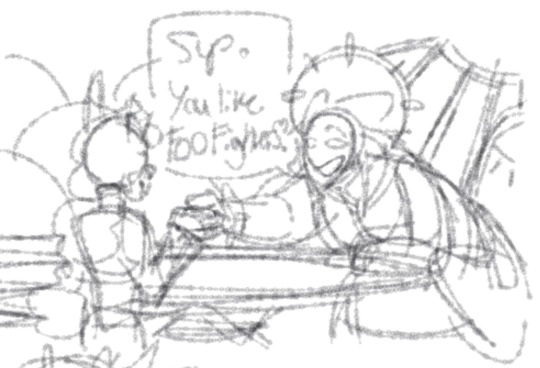

I also changed up what Charlie is as not only is she a doll, but she is also the manifestation of “free will.” Spawned from Lilith and Lucifer’s union being an action that goes against "god's plan."
Although she barely remembers it, her actions caused Adam and Eve to eat the apple. She partially made the hotel out of guilt for condemning humanity, feeling as though she has to make it up to the sinners she condemned.
This makes her super hesitant to push the patrons to get help as although she knows that it'll help them in the long run it must fully be by their own free will to want to change. This hesitance also leads her to not fully interfere in their afterlives either, even when she knows a push is all they'll need.
She is able to literally be anyone or anything, and she is scared of this fact. Kinda getting decision paralysis. Also being that she is a being made out of pure energy this essentially means she's a bomb.

This is the result of what happens to her once her form is broken.


These are the old designs, went with a more streamlined look later.

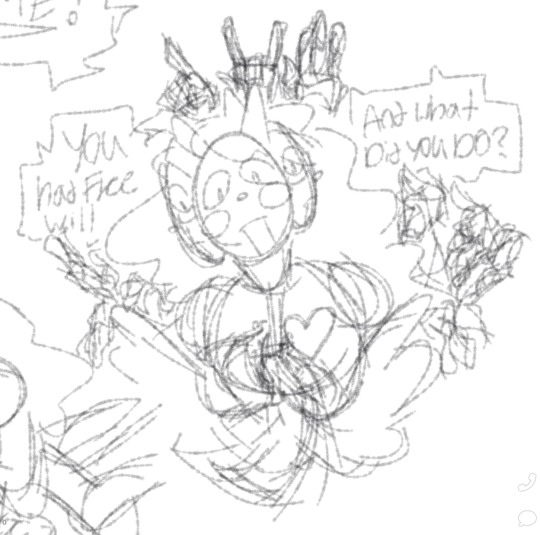

Heavily inspired by the final form of the Princess from Slay the Princess. A game I highly recommend!

When in her "chimera form" she accidentally kills Adam, leading her to take him on as a guest at her hotel. It also leads her to convince Heaven and Hell to use Mount Purgatorio for her new liminal hotel. Kinda using Adam as a bargaining chip to show heaven that if angels can fall, then that doesn't mean sinners can't climb up the mountain to Heaven.
Overtime, with more horror influences I kept adding into her character and design I accidentally just made her into a creepy doll with some analog influences.
(It's almost like my subconscious is trying to tell me something 🤔)
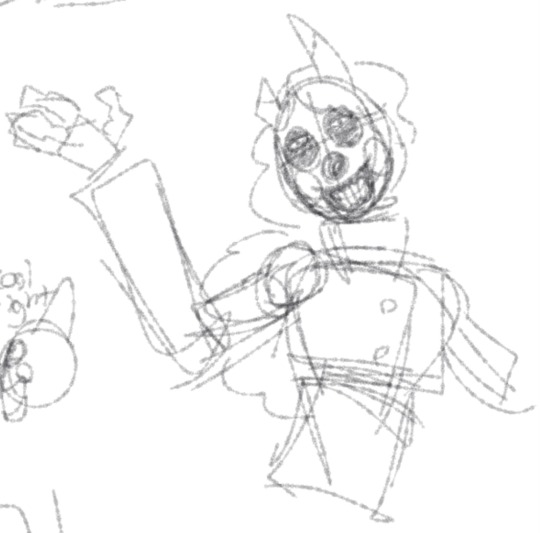
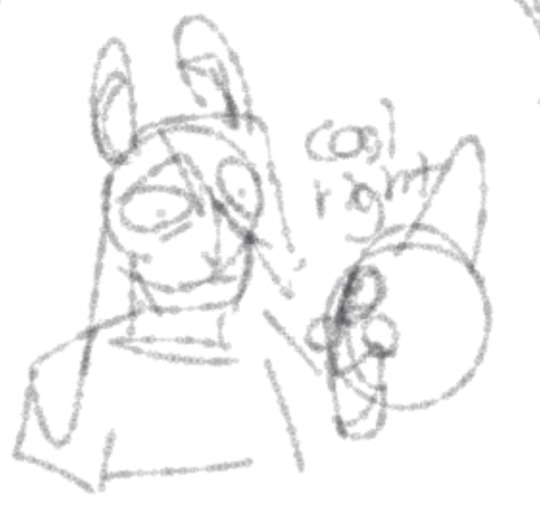
Vaggie and her scary gf.
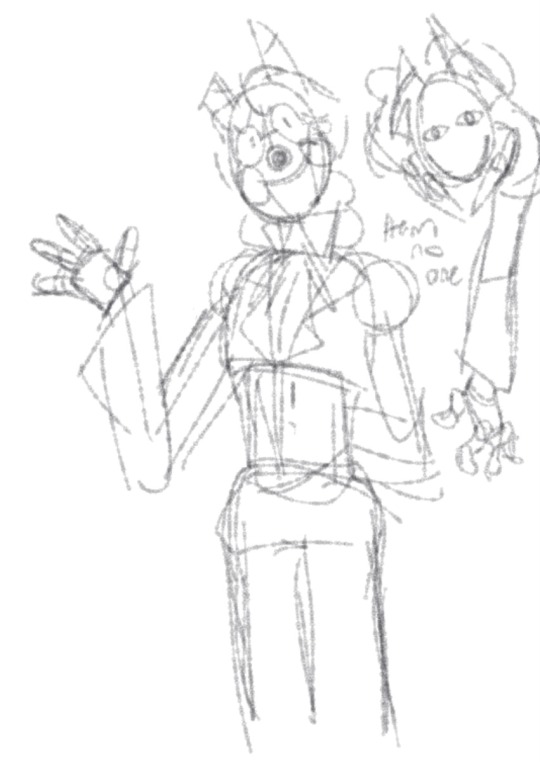

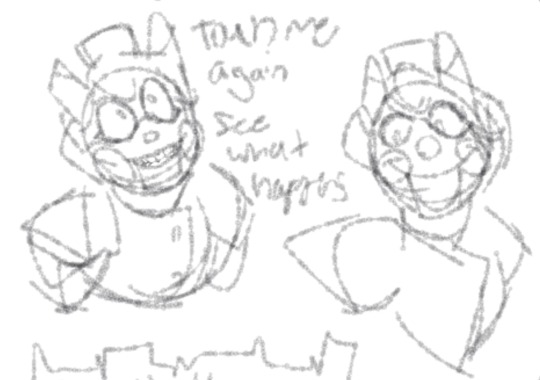


Decided to go for a more psychological route for Charlie’s abilities and personality. On the surface appearing normal, but still standing out in most environments because of her simplicity. That there's just something about her that doesn't quite fit anywhere.

Her character finally clicked for me after watching Paranoia Agent. She's not really based off any characters from the show, but some of the themes and imagery are baked into her character.
Along with the banger opening.
youtube
Eventually she builds her hotel in purgatory, and essentially becomes its ruler. Much to the chagrin of Heaven, who still only sees her as a demon. Even though she was technically born in the heavens.

Even though Charlie uses Adam as a bargaining chip they don't really care that he fell. But they don't want to be proven wrong either, so they reluctantly agree to the idea.
Also lil bonus of Charlie and Vaggie in nightwear. Gotta make another post for Vaggie, but I’m still working some things out with her story and character.

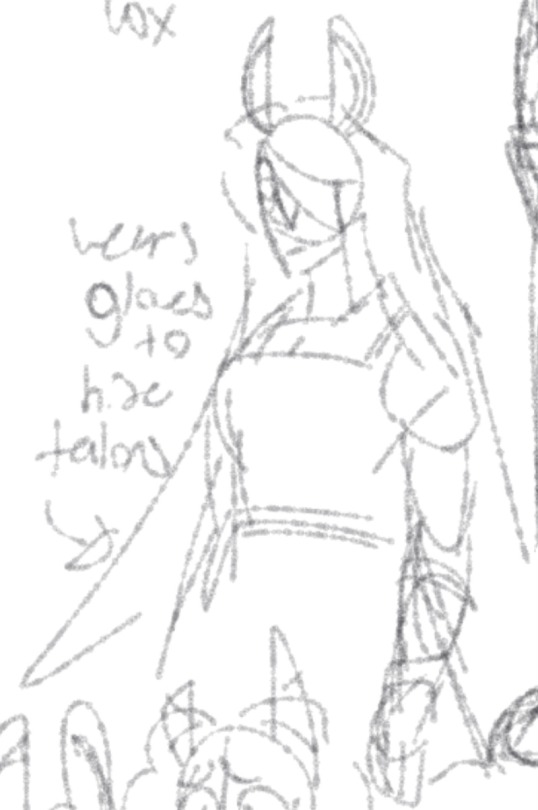
I apologize if so much of this post made no sense. I didn't realize how much I had written for Charlie. Although makes sense as she is supposed to be the main character.
I am happy to answer questions if y'all want more clarification.
#Youtube#charlie morningstar#hazbin charlie#charlie hazbin hotel#hazbin redesign#hazbin rewrite#character redesign#character rewrite#vaggie#horror#horror art#sketch#digital sketch#sketch dump#sketches
29 notes
·
View notes
Text

What's that? HOT single dad with BIG naturals in YOUR area Hazbin Hotel tag? More likely than you think!
Ok, jokes aside, I've decided to try something new for myself and redesign HH Lucifer. I'm gonna preface this by saying that I'm not a professional character designer (in fact I can barely draw), but I tried anyway just for the fun of it.
Sorry I took your goofy tumblr sexyman wannabe and turned him into a depressed dead-beat dilf, who's deeply unamused by the shit happening around him. Also he is trans and doesn't even bind (like a king he is) because I have to represent Viv's biblical lore as accurately as possible.
*Disclaimer: under the cut you can find an obnoxiously long text detailing my design choices. It's probably poorly articulated and not at all amusing, so you can just skip it. Also there's a badly drawn hat somewhere down there, so beware.*
I'll begin with the most obvious: Lucifer's main inspiration for his look was the ram. Mostly because the goat is supposedly already taken by Satan if I remember VivziePop Lore correctly, but also because it's a direct reference to a sacrificial lamb. I used images of a Jacob sheep as a reference, for multiple reasons: 1. Their fur often has a two-colored pattern (usually black/dark brown and white, which will become important later), 2. Sometimes they can grow as much as four horns, which kinda gives me this occult, almost demonic vibe, I was going for. 3. They're kinda cute. Look at them majestic beasts:


Moving on.
In the hellaverse the seven deadly sins are supposed to be themed after different types of circus performers, and Lucifer wasn't an exception, his outfit clearly being inspired by a ringmasters' costume, while his white face with red cheeks are supposed to resemble a clown makeup.
I've decided to keep the circus theme and run with it (maybe a bit too far, as you will see in a second).
My first point of reference was the same as in the original: the ringleader. Given the chosen theme it kinda makes sense, since he is supposed to be a main ruler of hell. You can really tell that he runs this circus. Awful jokes aside, his upper wear is obviously inspired by a circus ringmasters' outfits, with a mix of trates from another character that can be sometimes found performing in a circus, which brings us to:
Pierrot. Now, although his character originated from the Italian theater, pierrot can be considered a clown in a more modern sense. (At least I think so. If I'm wrong clown experts can kick my ass in the comments, I probably deserve this)
Pierrot often characterized as a melancholic, a sufferer and a tragic lover. When it comes to the humor in the circus setting specifically, it usually comes from the pierrot's melancholic nature and often involves his clumsiness and kind of self-deprecating slapstick, which I find quite fitting for a man who fucked up so bad that he isolated himself from the rest of the world and who's wife left him because of that. Lucifer's whole life after the fall has been one giant unfunny joke, and he isn't coping well with it.
Elements of a pierrot costume can be observed in the white jacket, the coat lapel of which is mimicking a frilled collaret. The fur pattern on his face is also a reference to a pierrot's make-up: a white face with black (well, brown in our case) tears.
Lastly, you probably have noticed the shirt, which has the main colour accent to it. It's actually inspired by a strongman singlet.
I've decided to give it less stripes for simplicity (also because I'm lazy). He's supposed to be wearing shorts and a sleeveless shirt underneath his costume, but I'm too tired to draw another image, so I guess you have to use your imagination on that one. I'll be frank, it's mostly supposed to be a little nod to the fact that Lucifer is supposed to be a strongest being in hell. Yeah I included it into my design because of a bad pun.
On a second thought, it's probably not great that I've tried to crum in three different types of circus performers into one character, but I'm not a professional character designer, so I legitimately do not know if that's ok. More experienced people are welcome to critique or correct me in the replies/comments.
BONUS:
While finishing the first image I randomly thought to myself that besides the ringleader elements, there's may not be enough clues that he's a monarch. So I decided to do a separate image where I clown around to try and redesign his crown/tophat, so here it is:

And if I decided to break down my thought process designing Lucifer himself, I might as well do it here also.
I've decided to keep the crown and ringmasters' tophat elements. I used images of a ringleaders' tophats and the imperial state crown as my main points of reference.
All the metallic elements of the "crown" are actually made out of pyrite, also known as a fool's gold (you can really tell that I'm a fan of dumb puns). I decided to used it to further showcase how Lucifer ruling the hell is treated like a joke.
Chains surrounding the tophat are supposed to represent how Lucifer was unwillingly thrown into this position and it weighs him down.
These two rings at the bottom are supposed to look kinda like a snakeskin (yes really), which is a reference to that scene where he turns into a snake to give Eve an apple. Speaking of which:
At the top is placed an imperial orb, with a upsidedown star (pentagram) instead of a cross. It carries the same meaning as a regular imperial orb in a sense that it shows monarch's power, but it's also kinda mocks the regular globus cruciger. (Fun fact: russians sometimes call it something like a "monarch's apple". I just thought it was kinda funny considering the context I'm using it in.).
The rest of the elements are taken from a regular tophat ringleaders' usually wear.
Anyway, that's all I have. Feel free to leave your thoughts in the comments or replies, I'll gladly read them.
24 notes
·
View notes
Text
Finally for the first time tryin to draw this man

Just a lil doodle while in class.
Also had the sudden inspo bc of a lil thingy(AU? Would it still be considered AU if i dont plan to expand?). Ik Angel!Alastor AUs are a thing, at least i think so, so i decided to try it out a lil bit.
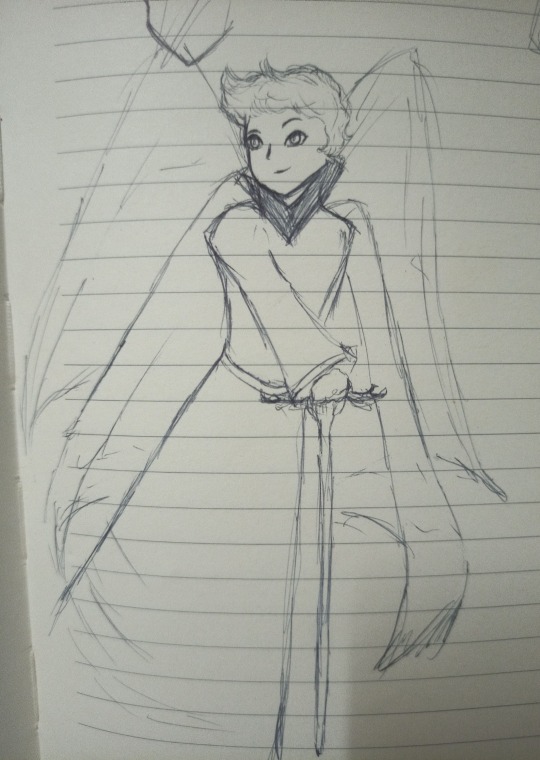
So tadaaa, Angelic Alastor. I cannot draw wings to save my life, so bear with me. I based the eye shapes and over all facial expressions on how i drew the first Alastor doodle, except its a teeny bit less sharp with less bolder lines. I shaped his hair somewhat the same for the top part, except a bit slicked back with a more windswept look. I imagine his hair would be white with red tips, with an overall white, and red color scheme, with a black collar standing out. He'd have the same red eyess, tho with whites surrounding it.
I gave him two wings, to maybe signify that he is above most angels, though below those such as the Seraphims and Archangels, at least in rank. I was a bit conflicted what to make his cane like(yea ofc im giving him a cane im not a monster). Originally i wanted to copy what his lil antlers looked like, as to be a simple staff, but ended up with that wider antler design. Idk.
Angelic Alastor wouldn't really be much different than Demon Alastor, except for the fact that he's better at hiding it all, at least he wants to. He's quite powerful amongst other angels, moreso than seraphims despite being of lower rank. Similarly to how he can melt in the shadows, as an angel, he can dissolve into the light. Haven't really cemented what exact type of angel he is, though i'd imagine he's still a bit of a recluse, preferring to go off alone to do as he wishes.
Angelic Alastor is every bit as mischievous as his demonic counterpart. He lives for the entertainment, and his humor's quite biting for a being of light. He's sharp and charming and witty, and quite rebellious as well. He's curious about different possibilities, and has never quite felt like he belonged among his "perfect" angelic peers. He knows he's imperfect, and that all those ideas would be considered blasphemous. So he remains quiet, under the radar even with his strength; all to escape the possibility of being persecuted.
Its what draws him to the Morningstar. Lucifer, the powerful archangel with a heart of gold and a mind filled with wonder. (Also to anyone who's seen my blog, yes ofc im inserting radioapple im weak) Despite their gap in rank, Lucifer never treated him any differently, and Alastor found himself treating the shorter angel as an equal. Their friendship was a bit odd perhaps for the others, considering how they'd often greet each other with playful jabs and teasing remarks, all quite informal and rather unruly. He was drawn to Lucifer's ideas, as was Luci to him, both relishing in the fact that they weren't alone, despite being different.
Lucifer had always been the louder dreamer. Though Alastor often agreed with his ideas, and sometimes egged him on, Al knew the risks and knew when to pull back. He was cautious where Lucifer took risks.
And y'all already know its Radioapple but what if we add Lilith to the mix-
Like imagine, Lucifer coming back to Alastor and gushing about the first woman, the taller man amused at his friend's lovesick expressions. Imagine him being acquainted with Lilith, and charmed as well by passion and hopes for change. He's weak for dreamers okay-
Like imagine him helping the two hide their relationship, being the most cautious of the 3. Imagine his heartbreak when the two gets sent to hell. Imagine Lilith and Lucifer holding him, stopping him from falling with them, because he cant do this without them please-
This may have gotten away from me a bit
Anyway, there's also a teeny doodle of biblically accurate Angelic Alastor(idk ehat to call them, but those forms Sera and Em have when they go 👁👁👁👁)

Idk if i'll ever do anytjing with this. I have a whole fic playing in my head but its very long with a whole lot of plot and idk if im strong enough-
#Angelic Alastor AU#hazbin hotel#alastor#lucifer#lucifer morningstar#lucifer magne#lilith morningstar#lilith magne#hazbin hotel lilith#hazbin hotel alastor#hazbin hotel art#art#my art#bloopnik art#alastor the radio demon#radio demon#radioapple#appleradio#radio apple#apple radio#radioapplith#lucifer x Lilith#Alastor x Lucifer x Lilith#hazbin#doodles#fic ideas#Hell's strongest throuple#poly#traditional art#bloopnik writing
41 notes
·
View notes
Note
Hello there,
I have a question about Ludwig, does he interact with any of the Broodals? Was he friends with any of them before their sort of 'transformations'?
Also, your drawings are like the biblically accurate angels of Mario art and I love them so much🤩
Have a nice day👋
First of all, thank you so much! I'm glad you are enjoying my art! I hope you have a nice day as well 😁.

As for Ludwig, he was never friends with any of the broodals, though he did know about them before they perished. He saw them around when they were working for Bowser. He never really interacted with them because he didn't really care about what they were doing. They didn't cause any harm, and Bowser himself hired them.
After the broodals stopped working for Bowser, Ludwig didn't see them around much anymore. There were still a few interactions between them though. He met with Spewart at that time because Roy was starting to become friends with him. Hariet also visited the castle sometimes, but she always snuck in. The koopa kingdom didn't really want to associate with the broodals anymore because of their tarnished reputation.
After the "transformation" of the broodals, the koopalings saw them more often. Hariet constantly follows Ludwig (like she does to Spewart) whenever she is around him.
MT respects Ludwig, though they are not friends. MT doesn't dislike Ludwig, but Ludwig thinks MT is disgusting.
Sometimes Roy and Spewart try to pull Ludwig into their shenanigans. He finds them both annoying.
Ludwig and Emar don't interact much. Emar might be the only broodal Ludwig doesn't dislike because of this (but if they interacted more Ludwig would definitely find him annoying too).

Here's a little doodle of him :D 👍
9 notes
·
View notes
Text
oh my god you guys @loganmothman and i are working on a Good Omens AU and AAAAA ITS SO COOL
most of this brainrot so far is my doing, but to be fair it was his idea first (and when we get a plot going i will be writing and he will be drawing :DD right? i think so- (logan plz confirm that)
ANYWAYS! enjoy this for now! there will prolly be more info added later hehe :3
Church AU Brainrot
-Crowley- 🐍
- serpent from eden, became a priest to avoid the choice between heaven and hell
- holy water tears, leaving scars due to the half of him that is still hell incarnate
- he/him (secretly he/they)
- feels extreme guilt on behalf of both sides of him, when he does something good he betrays hell and when he does something bad he betrays heaven
- religious trauma to the MAX (if that wasn’t obvious already)
- becomes good friends with Nina and Maggie (will develop backstory for that later)
- often very quiet. he doesn’t lead any like mass, he mostly just hides in the background (to avoid being found out by the churchgoers) but he does occasionally allow people in to see him one on one (this is a very rare occurrence tho)
- remembers the angel of the east gate, and thinks about her often. he can’t really figure out why, but he often feels like she’s there with him.
- They were together (as in how they are in the show, running into each other every once in a while) until 1827 (grave robbing minisode) when Crowley decided to become a priest. He was overwhelmed with uncertainty about how good heaven actually is, but he didn’t want to stay with hell and be forced to hurt people, or let them hurt themselves.
- he often writes in a journal, sometimes seeking God’s help and sometimes seeking Satan’s. (it’s like his personality is split in half, and when he feels both he is in immense emotional distress)
- When he gets very stressed/angry his eyes turn full snake and he has to step outside of the church (consecrated ground)
- when he feels happy (rarely) or feels love (aka the presence of Azi) his eyes turn blue
How Crowley met Nina and Maggie:
There’s a small apartment right above Nina’s coffee shop, and one above Maggie’s record shop. Nina has her own apartment, so when Crowley got his Hell Appointed apartment taken from him- he didn’t know what to do. Nina noticed him living out of his Bentley and offered for him to rent out the apartment. Because he doesn’t make much money as a priest, he helps out at the shop when he can and collects tips to begin paying off his debt to Nina. (Even though Maggie has convinced her not to make him pay as much as often. We also see a little of Maggie and Nina’s relationship explored through Crowley’s interactions with them. Because of their love, he begins to find hope for himself- later finding out about the ineffable bureaucracy and having a crisis)
-Aziraphale- 🪽
- Angel of The East Gate
- uses all pronouns (i use she for her mostly tho)
- A representation of a biblically accurate angel (multiple halos, tons of glowy eyes and extreme power)
- fell in love with Crowley in the garden of eden.
- Azi did have a “human ish disguise” up until the incident in 1827, where Crowley decides to become a priest due to not wanting to get punished for saving and helping people. Azi was therefore banished to heaven for failing to “defeat evil”
- They were obviously distraught to be torn away from him, especially when he could use guidance now so she started to secretly watch over him when she could. they became a guardian angel of sorts
- behind the scenes she’s been trying to find a way to get back to earth for him
- Started her studies to become a “better servant of god” which then in turn made her a guardian Angel of sorts
- they desperately want to help Crowley choose (mostly heaven but it’s a guilty thought for them) so he isn’t stuck in this terrible limbo between
- Azi isn’t respected in heaven, but he holds out hope and never lets it get him down. they’re the good guys, so whatever they do has reason :) (oh yeah, she’s got trauma too. very very blinded. she struggles to understand why Crowley won’t pick a side, but she loves him anyway)
#gomens#gomens au#my au#YAYAYAY#i’m having a lot of fun with this one#yeah there’s more about crowley because he is my boiest boi but there will be more info an azi’s character later i promise#eden is going slightly insane#aziracrow
2 notes
·
View notes
Text
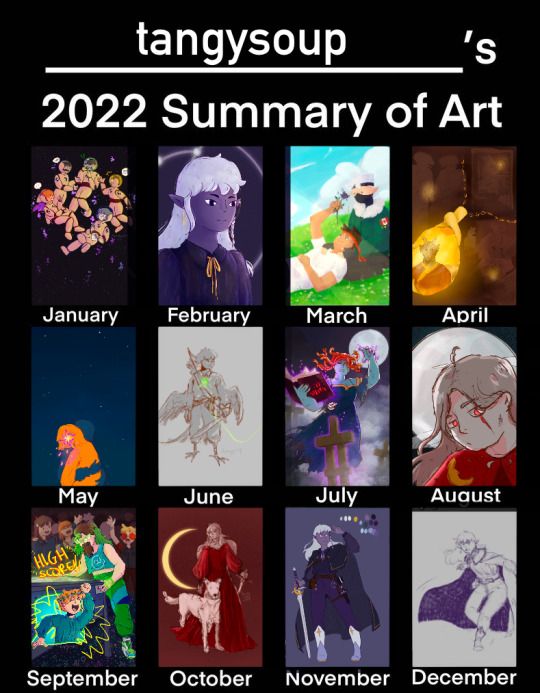
Hii lookie! Even though I only made like 4 fully rendered pieces this year, I'm happy with what I've done this year!
(For months where I dont't have fully rendered finished pieces I put in the next closest thing I have that month.)
Ramble under the cut where I try to go over each month
General overview:
Funny thing I've noticed is how often I used cool tones this year bc my older art (that ive never shown from like 2 years ago) was characterized by warm tones
Even though I work through fully rendered pieces super slowly and barely come out of the year with any, I'm super proud of my progress this year! I've learnt and grown a lot as an artist and have also realized my potential. With that though also comes my fear of not being able to top what I've done, which I'm trying to work on! My issue is I tend to produce a lot of art when feeling highly inspired by a media, and right now I don't exactly feel the same kind of spontaneous and passionate inspiration as I did during the year. I'm definitely dealing with some sort of mental block right now when it comes to digital art and I'm hoping to get through that soon because I miss the process of making something I love through drawing!!
January:
honestly thought the boatem piece was done last year so I was surprised to find it in my January files! This piece was kind of a turning point for my art as it was my first more complex pieces (i had not previously done a piece w more than 1 character in it really). It was a lot of work and I was very nervous about it but I'm quite proud of what I was able to do!
Late january is also when i started sketching out the ethubs piece actually (i work slow)!
February:
I didn't actually do a ton of art this month, as I tend to take a break and slow down right after finishing a piece. At this point I was very keen on doing pose studies traditionally. I posted some of these and most of them were desert duo.
This month i started to really figure out my dnd character Ethe's main design as our campaign was starting. So, i did a portrait of her for that. The rest of February was working on ethubs and studying how to paint grass and clouds and just sketching here and there. I think desert duo brain rot was strongest this month
March:
March was also a mix of pose studies and random sketches and FINALLY FINISHING ETHUBS. I was also doing some art for dnd ^_^
April:
I finished the dragonborn npc centered dnd piece this month, and also began sketching out the cleo piece. In between working on cleo I did some joe art including an animatic featuring the wordle boarder and the sketch for biblically accurate joe :D
May:
Pretty much anytime i had procreate open in may I was working on Cleo. This is the most ambitious art project I have taken on and I wasn't sure if I was able to make it how I wanted, so I was kind of slow and on and off with it. I ended up putting it down towards the end of the month and did some more personal illustrations
June:
Big month for my dnd blorbos tbh! I introduced a sister for Ethe and was working on her design and their interactions. I also got a bigger sketchbook this month and did a bunch of traditional studies. I finished the flats for cleo this month and took a break so most of the art I did were sketches
July:
I was in the home stretch for cleo and with the help of my friends telling me to finish it i finally pushed through and finished it. I couldnt be happier w the results!! it's one of my proudest pieces this year and I put in so much work for it. But after I finished it i took a huge break from mcyt art and focused on dnd art yet again.
August:
My work for the multidimensional big bang started this month!! I worked out the character design early august and had a sketch for the full piece by the end of the month. In the meantime I was actually working on a cat painting I never posted... maybe I'll post it in an end of year art dump
September:
This month was all about the big bang piece. I had so much fun doing it and am super proud of the finished product. Im especially happy with the composition and inclusion of the background characters!!
October:
Again. Major break from making full pieces after finishing a huge one last month. I think I spent more of my creative energy elsewhere like my writing. Also school started again and I had moved apartments and there was a lot of irl stuff preventing me from drawing. I did try to do traditional studies if I could
November:
Kind of a dead month for drawing. Super busy w school, chugging my way through Ethe's ref sheet i started months ago.
December:
Literally haven't drawn anything new besides a new years illustration for greeting cards. I picked up crocheting again and have been spending a lot of creative energy on that instead, but to keep my drawing going I've been doing more figure studies in my sketch book i guess!
10 notes
·
View notes
Text
Core Fear
Today's inspiration comes from:
Good Boundaries and Goodbyes
by Lysa Terkeurst
Editor's note: Good Boundaries and Goodbyes Online Bible Study Online Bible Study by Lysa TerKeurst starts 7/24! Sign up today and join us as we learn how to have biblical boundaries for healthy relationships.
"'What if, when trying to apply your boundaries in an emotionally charged moment, you lose your resolve, because the other person makes statements that confuse you, make you question the validity of this boundary, or accuse you in ways that hurt? You need to be prepared to know what to do.
See if you’ve heard any of these types of statements from others. Assess whether these statements have contributed to you giving up on setting boundaries with certain people.
When they say:
“What I did isn’t that big of a deal. You’re being so dramatic.” “You are being overly sensitive.”
“And you call yourself a Christian?! Jesus wouldn’t treat people this way.”
“I thought Christians were supposed to be forgiving.” “You’ve got such a hard heart. Jesus would have never walked away.”
“This is just more evidence of you being controlling and unforgiving.”
“Jesus loved all people and gave grace no matter what. So, what’s your problem?”
“You don’t seem like yourself. You’ve changed.”
“I’m so disappointed in you.”
“You’re just crazy and this is irrational.”
“You’re so selfish. All you care about is yourself.” “Seriously?! How can you be so mean after all I’ve done for you?”
“You’re so off base. Drawing boundaries isn’t biblical.” “But you’re my (wife, daughter, best friend, mother, sister). Acting this way toward me is out of order and unacceptable.”
Here’s why these statements are so triggering:
They are offensive. They aren’t an accurate picture of what’s true about who we are. Being misunderstood is so brutal because someone else is taking liberties with our identity.
They are threatening. When someone makes hurtful accusations and pushes against our boundaries, it can feel as if whatever this relationship is providing for us will be taken away and some need in us will go unmet.
They are disillusioning. When someone else makes us question our need for the boundary, we can second-guess reality, our sanity, our rationality, and even the severity of what’s really going on. We can easily start to wonder if the real problem is us rather than considering the source and why we are in this hard dynamic in the first place.
Join the OBS
It is so very important that we are aware of all three of these feelings that can make us vulnerable to not establishing wise boundaries. Here’s the first thing we need to notice about the effects of these triggering statements: they are each evidence that we need to establish a boundary with this person.
And here’s the second thing to notice: if we are afraid that this person will think poorly of us, potentially abandon us, or try to make us feel crazy for taking a step toward making the relationship healthy, chances are even higher that, without wise boundaries, they will eventually do all three of these things to us. (Dear me: read that last sentence one more time... maybe ten more times.)
Unhealthy people typically don’t manage their emotions and expectations (self-regulate) very well and can easily get offended when their lack of responsibility doesn’t become your emergency.
Their thought process is often that their need trumps your limitations. And the telltale sign of their unhealthiness is their unwillingness to accept no as an answer without trying to make you feel terrible, punished, or unsure about the necessity of the boundary.
If we want to stay healthy, we have to use our limited energy in the right way. We could waste years putting all our efforts into trying to change the other person’s mind or prove to them why we need the boundary, or worst of all, we could drop the boundary altogether and continue living in dysfunction.
Let me state something crucial. I don’t want us to suddenly start categorizing everyone around us as healthy or not healthy. But we must pay attention to those who accept our healthy boundaries and those who resist them.
The apostle Paul addresses some key components to love:
And this is my prayer: that your love may abound more and more in knowledge and depth of insight, so that you may be able to discern what is best and may be pure and blameless for the day of Christ.
What I like about Philippians 1:9–10 is that the love here is associated with knowledge and discernment. So, the inverse is also true. A lack of wisdom and discernment is actually unloving. Sometimes we only associate love as a feeling. But we have to remember that biblical love is an intentional action where we want what’s best for us and the other person. Keeping this in mind, when setting boundaries our heart posture should be one of wisdom and discernment for the sake of true and healthy love.
Healthy people who desire healthy relationships don’t have an issue with other people’s healthy boundaries.
Hebrews 5:14 reminds us that mature people “have trained themselves to distinguish good from evil.” That word distinguish means someone can discern more readily what is the right way to treat someone and what is not acceptable. What someone should say and what someone probably shouldn’t say. And just because a person can do something, doesn’t mean she should do that thing. Discerning and choosing one’s actions carefully leads to a wisdom that those around them can trust.
People not liking our boundary does not mean we aren’t living right before God.
Healthy people are mature people. They seek to understand your concerns,
discuss any issues that the need for the boundary reveals, and
respect your limits.
Remember, healthy people who desire healthy relationships know how to be responsible with the access you give them. For example, if they borrow your car, chances are they won’t return it on empty. But if they do, you can let them know that if they want to borrow it again, they just need to replace the gas they use. And they should see that as a reasonable request without making you feel anything less than generous.
Even if someone doesn’t like a boundary you have set, healthy people know the difference between hurt and harm. A friend who constantly runs late may feel hurt that you are no longer willing to ride with her to events but can recognize your boundary wasn’t put in place to cause her any harm. She won’t think that you’re selfish and rude. Nor will she blame her issues on you. And she certainly won’t diminish your identity, disrupt your safety, or disregard your assessment of reality. She’ll either adjust her untimeliness and ride with you or just meet you at the event. Either way, she will respect you enough to respect your boundaries.
Healthy people understand your limits because they are in touch with their own limitations. They communicate what they can and cannot do — what they are and are not willing to tolerate. And they expect you to do the same.
Understanding this can help us realize sometimes the problem isn’t that we aren’t good at setting healthy boundaries. Maybe we aren’t good at recognizing that we won’t get healthy results from unhealthy relationships.
Somewhere in all the looking around at others for validation, we’ve stopped looking up.
If we are living honest lives that honor God, we must not forget that people not liking our boundary does not mean we aren’t living right before God.
When someone says something that hurts or offends us when we draw a boundary, it can be good to check ourselves. Is any part of this an attempt on our part to do harm, control, retaliate, check out, or give ourselves permission to be irresponsible? While checking ourselves is healthy, questioning our identity is not.
Checking ourselves means looking at a current attitude or behavior to see if it is in line with God’s instructions and wisdom. Questioning our identity is doubting who we are because we have given too much power to other people by letting their opinions define us.
I don’t know any other way to say this except to be absolutely direct: If our identity, the foundational belief we hold of who we are, is tied to an opinion someone has of us, we need to reassess. We must be honest with how much access to our heart we’ve given to this person. It’s not bad to give someone access to our heart but when we give an unhealthy person too much access, it can shake us to our core. When their opinion of us starts to affect how we see ourselves, we can lose sight of the best parts of who we are because we get entangled in the exhausting pursuit of trying to keep that relationship intact no matter the cost. And when this is the cycle we are caught in, sometimes we would rather manage people’s perceptions of us than care for ourselves and the relationship by putting appropriate boundaries in place.
When we give people personal access to us, those people must be responsible with it. And emotional access to our hearts is especially important.
Excerpted with permission from Good Boundaries and Goodbyes by Lysa TerKeurst, copyright Lysa TerKeurst.
0 notes
Note
Finally a blog with some yandere biblical accurate angel. Love you hun. Can you tell me more about your oc please he seems very interesting, the way you draw him is so pleasing to my eyes.

Sure! Not 100% sure where to start since I’ve never really shared OCs before but I’ll give you some basic info to start with. Oh, and btw, my friend @yandere-starchild also has some yandere angel OCs!
Angels within biblical stories get their name from the God they draw power from, according to a few religious based websites I looked into, which I could get into more but I’ll try to keep this to more of an introductory overview: Which is where the name Freisya came from (which is also why he has a single blue eye compared to his other eyes).
When designed him I wanted ‘his’ God to be some kind of floral/love god, so I looked into flower meanings to find a flower that I thought mixed the best with his personality — which ended up being freesia.
As the flower implies, Freisya is very sweet, loyal, and able to adapt to any kind of relationship with his chosen Darling! He’s not overly possessive because he trusts his darling, as he holds the values of trust and loyalty above almost anything else.
He’s more of an obsessive/near-constant stalker. Freisya tends to be a little overbearing when it comes to being touchy as he doesn’t get to touch others directly very often. Otherwise, he’s very calm but also very passionate when it comes to duty, and his darling is now part of that duty! He’s somewhat gender-fluid, so if his darling prefers another gender then he’ll just switch over to that gender. Though he does like to be masculine.
He does have some experience with humans but it’s not nearly enough to be considered ‘socialized’ so his human darling will either think he’s hilarious/cute/endearing or insanely annoying.
— What is this small mirror.”
— That’s a toaster...?”
— Ah, this ‘toaster’ is a mirror for your ‘kitchen’.”
— I, no that’s not—”
He’s around 9 ft tall or 274.32 cm in his human form. To end this ask off, here’s a little art sheet I quickly whipped up for a friend a week or so ago —

Forgive his lack of hands I didn’t feel like drawing them at the time of drawing </3
#Yandere OC#Freisya OC#ask#eldritchangel35eyes#Sorry if the formatting is weird! I wasn't sure how to go about this haha;;
45 notes
·
View notes
Note
Ocs? 👀
Ok so this going to be incomplete cuz I’m trying to see if I can find/draw references for some of the. BUT-

this is bethel rintub, an olive blooded homestuck troll who I MAY OR MAY NOT have drawn inspiration from toad. They are pretty blunt but also super Weird Fourth Grade Girl and likes making mud pie. special interest is pottery and sculpting :3

This is an older one, her name is Scylla, a fuschiablooded homestuck troll, and my thoughts with her was that she’d be so far on the hemp spectrum that her blood would basically be red, and then I made her a deepsea hermit because lots of abyssal creatures are red for camoflouge. She’s very shy, and wants to make friends but often says something inappropriate or macabre and gets odd looks. (my least favorite thing about her is her horns because I can’t figure out how I want em without em lookin goofy). ALSO BEST PART her lusus is a manta ray. Who she calls “Ray Dad”. as in Ray Dad sunglasses (he wears sunglasses all the time)
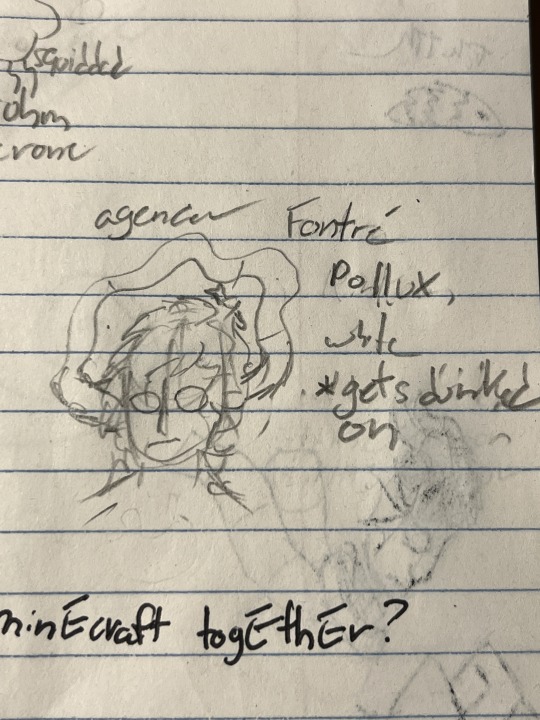
Here’s another new one! Another homestuck troll, (they/it/boo) boo is a mutant blood (gasp horrifying). it’s a white blood, sometimes also referred to as ghostblood or clearblood. I wanted more of an angel vibe, and if I ever draw godtie (read: figure out classpects) there’s is going to transition from ”classic” angel to biblically accurate angel. I’m not sure yet if I want to pull an stadia and have them be killed off and ghosty though… I could see benefits either way… they’re a little self deprecating and very paranoid but they hide it behind a mask of being the Cool Smart One. Fontré also is a botanist!
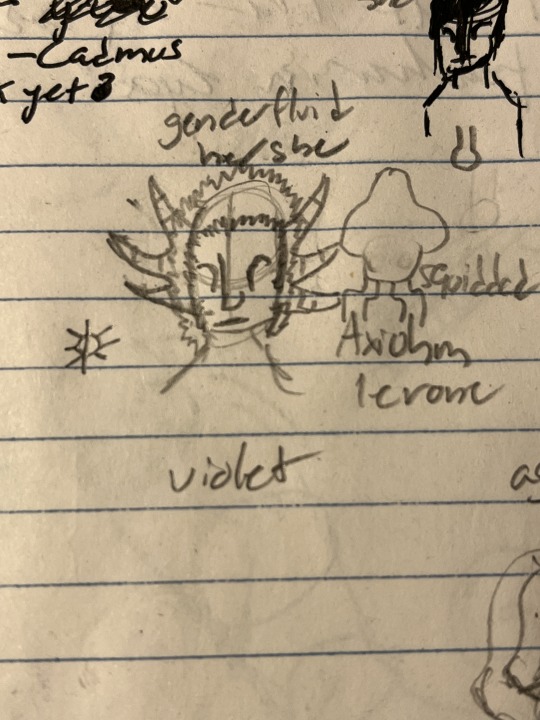
And finally for tonight we have Axiohm, who I actually got a symbol for (:0). he‘s based off an axolotl and pretends to be a prophet a lot. DEFINITELY knows more than what she’s letting on. His hairs like- yknow when you shave your head and you then let it grow out? Like that. Her Squiddad is based of a big fin squid cuz I love them.
———
and yeah! That’s it for tonight because phone sucks so I’ll prolly reblog with more tomorrow But ye! Now you can ask specific lore questions about some of these 👀
I also have homestuck ocs for every other caste except jade and cobalt so if you wanna ask me about those 👀
and finally feel free to ask about bnha ocs like Jamie Aguilero and family!
#dragon’s discussions#dragon’s deliveries#dragon’s dolls#<- OC tag now >:3#Love me some alliteration#dysprosium
1 note
·
View note
Link

Do you believe empathy can be spiritually dangerous?
I do, and I have tried to explain why and how. And as I have, I have received some criticism (some of it quite fierce). The criticism is not surprising. Most of us have categories for the way that certain passions (such as fear or anger) can become sinful; articles about “the sin of anger” or “the sin of fear” make sense to us. But in the modern world, empathy is viewed as an almost unalloyed good, and therefore the notion that it could be dangerous, and even sinful, may be shocking.
Nevertheless, the interactions and criticisms have been both illuminating and instructive. For instance, one group of responses sounds like this:
How can you call empathy a sin? Empathy is Christlike care for suffering people that seeks to deeply enter into their pain in order to help them. By criticizing empathy, you must be advocating for an aloof, uncaring, and unchristian response to suffering people.
At a basic level, this criticism of my argument is simply false. It’s a misrepresentation of what I’ve said and written. It defines empathy in a positive way (Christlike care) and then acts as though I attacked that understanding of the term. But my burden has been precisely the opposite: to encourage Christlike care for suffering people. So, how do some of my critics draw their conclusions? I believe they fail to practice what we might call “Golden Rule hermeneutics”: Am I doing unto authors as I would have them do unto me?
Now, not all of my critics have responded to a straw-man version of my arguments. Many of them have sought to genuinely engage with the strongest versions of my arguments, and I have been grateful for their clarity and charity. The debates, however, have given me an opportunity to revisit several vital principles for disagreement within the church.
Clarity and Charity
One of my key convictions is that clarity and charity hang together. Clarity serves charity; charity seeks clarity. Loving others well means that we seek to avoid ambiguity and vagueness, and bring light to confusion and darkness. Nowhere is this more needed than when we are engaging with our theological or political or philosophical opponents.
In my classes at Bethlehem College & Seminary, I am constantly pressing my students to love others by seeking clarity. We ought to regularly ask ourselves hard questions when we’re engaging with other perspectives, whether of dead authors or living people. Two questions in particular guide my own attempts to seek clarity and charity.
1. Have I Understood and Represented Rightly?
When engaging with others, I regularly ask whether I’m understanding and representing them accurately and fairly. In other words, am I doing unto authors as I would have them do unto me?
Because I want others to read my writings charitably and represent my position accurately, I likewise strive to read others charitably and represent them accurately. Whether we are reading Plato or Dante, Hume or Edwards, our first goal is to observe accurately, understand clearly, and represent these thinkers fairly. Only then are we in a position to evaluate and assess them rightly.
Developing these habits of heart and mind is not easy. It’s far easier to set up straw-man arguments and attack them, especially when dealing with positions and views that we reject. To counteract this tendency, I regularly require my students to represent an author’s questions, concerns, and thoughts in a way that he would embrace. If he heard them reproduce his arguments, he should be able to say, “Yes, you’ve expressed my position well.” Then, having represented his view fairly, they are free to evaluate and criticize what they’ve understood.
Steel-Man Arguments
Even more than that, I frequently try to “steel man” an opponent’s position. A steel-man argument is the opposite of a straw-man argument. When we erect a straw man, we present a weakened caricature of our opponent’s position, which makes it easier to knock down. Social media incentivizes this sort of engagement, as we aim for the “mic drop” moment. It’s easy to find plenty of cheerleaders who will applaud when we demolish our opponents (or at least, the straw man that we’ve attached to their faces).
In contrast, a steel-man argument seeks to represent an opponent’s position better than he did. We might supply an additional argument for his position — one that he did not advance — in order to present the strongest expression of that position. This sort of exercise is an act of love towards him, and towards those who agree with us. By strengthening views that we eventually reject, we can become aware of limitations or weaknesses in our own arguments.
Lewis on Purgatory
For example, when I teach a class on C.S. Lewis, I discuss his belief in the doctrine of purgatory. Lewis is quite clear on the matter. In Letters to Malcolm, he says, “I believe in Purgatory” (107).
It would be wrong, however, to conclude from this statement that Lewis believed in a temporary hell for Christians, in which devils torture saints for a limited period of time. More than that, it would be wrong to infer from Lewis’s belief in purgatory that he likewise would have embraced the medieval Roman Catholic doctrine of indulgences that so incensed Martin Luther. In both of these cases, we know that such conclusions are false because Lewis tells us so in the paragraphs following his statement about believing in purgatory. He explicitly rejects the notion that purgatory is a place of retributive punishment, as well as the idea that it demands commercial transactions in which living saints pay money to release dead relatives early from their torment.
Thus, when I teach Lewis, I first attempt to describe accurately his beliefs about purgatory — it is a temporary season of purging in which the saved soul desires to be fully cleansed of the vestiges of sin before fully enjoying the presence of God. Then, having described Lewis’s view accurately, I provide biblical and theological reasons for rejecting Lewis’s perspective. But as I try to make clear to my students, we gain the right to criticize only through accurate representation of opposing positions. This is one way that clarity serves charity, and charity seeks clarity.
2. What Kind of Difference Is This?
But beyond accurately representing the positions of others, we also aim for clarity by seeking to determine the nature of the differences between various positions. For example, as my students seek to understand and begin evaluating other positions, I encourage them to ask probing questions in their assessment.
Is this a difference in semantics? That is, are our positions substantially the same (we believe the same things), but we are using different terms to express our common belief?
Is this a difference in substance? That is, is my position substantially different from the other person’s?
Is this a difference in emphasis? That is, are our positions the same, but what we emphasize or accent about our positions is different? Do we have different instincts or different assessments about various dangers and temptations concerning our position?
So, how might an understanding of these kinds of differences bring light to the empathy debate in particular, and help us pursue unity in our differences?
Semantic Differences
I believe we have more agreement over empathy than we often acknowledge. For instance, I have been advocating for Christlike care for suffering people that seeks to enter into their pain in order to help them — while remaining tethered to the truth. The real question, then, is what the best term is for that Christlike orientation. My argument has been that compassion (or sympathy) is the best term, one derived directly from the Scriptures (1 Peter 3:8; Hebrews 4:15; 10:34). Others disagree, and think that empathy is the better term. But either way, if we’re agreed on the concept itself, then the difference is a semantic one, not a substantive one.
Now, semantic differences can be significant. They might create confusion. Some have criticized my arguments on empathy on precisely these grounds. These critics share my substantive concern but think that defining empathy as I do and talking about “the sin of empathy” is confusing to people. They’ve suggested I use a term like “sinful empathy” or “untethered empathy” or “ungoverned empathy” to distinguish the bad kind from a good and valuable form of empathy.
And while I intentionally used the provocative phrase in order to arrest attention and provoke thought (just like one might even seek to recover the word hedonism for Christian use), I’ve also been clear that I’m not hung up on the particular word. I’ve criticized the phenomenon without using the term empathy (“Dangerous Compassion”). And I’ve commended certain understandings of empathy, both in my own writing and in the writing of others. Therefore, untethered or ungoverned empathy seems to me to be an excellent term for the danger I’m encouraging us to avoid.
The main point here, however, is that it’s crucial to distinguish semantic differences from substantive differences, and that to treat a semantic difference as though it were a substantive one is often to misrepresent someone.
Emphasis Differences
The same is true of differences in emphasis. For example, in my writings on empathy, I’ve especially focused on the danger of total immersion in the pain of others such that we lose touch with truth and allow other people to steer our emotional vehicles. I have attempted to help people realize when they are being manipulated by the sensitivities and pain of hurting people. Some critics, however, believe that a more pressing danger is the kind of aloof sympathy that simply utters the words “I’m sorry that you’re hurting” but never takes risks to actually help the sufferer. In this case, different assessments of the more pressing danger lead to different emphases. With any given issue, we each have to ask, What is the need of this hour?
Different assessments of the need (or danger) are frequently owing to different personal experiences and backgrounds. If you’ve seen or experienced emotional blackmail in the name of empathy, or if you’ve seen Christians divided because some have adopted the logic that “I’m hurt; therefore you sinned,” then you’re more likely to be aware of that danger and thus emphasize the need for a deep respect for objective truth and goodness in our efforts to help. On the other hand, if you’ve seen or experienced callousness and empty words of compassion in the face of real suffering, or you have detected a fearful unwillingness to enter into the pain of others, then you’re more likely to be aware of that danger and thus emphasize the need for intentional efforts to weep with those who weep and mourn with those who mourn.
And differences in emphasis, of course, can also be significant. In the long haul, they might actually lead to substantive differences. We can lean so far in different directions that we wind up with different positions. But as I’ve stressed to my students, they don’t have to. In fact, rightly governed, different instincts and emphases can help to ensure that a church, or a pastoral team, or a school maintain a full-orbed embrace of Christlikeness.
Different emphases among those who mutually respect one another and who value the different instincts of the team can be of great benefit to a church. The pastoral team that I serve with has precisely this sort of mutual respect. We make better decisions precisely because we bring our different instincts and leanings into the discussion, all while sharing the same fundamental convictions.
Where We Disagree
Personally, I’ve found the debate surrounding empathy and compassion to be very illuminating. Good-faith critics have helped me to hone arguments, identify various fault lines, and, as a result, (I hope) provide more clarity to parts of my arguments that confused some. Bad-faith critics have served my sanctification in other ways. More importantly, though, I hope that this specific debate might equip us for future disagreements (of which there will be many).
In all of this, our goal as Christians must be to practice Golden Rule hermeneutics. As hearers and readers, we ought to listen and read with clarity and charity, seeking to understand authors on their own terms. We should assess whether relevant differences are matters of substance, semantics, or emphasis, and represent others with faithfulness and care. Likewise, as speakers and authors, we ought to speak and write with clarity and charity in our various contexts, seeking to be wise, courageous, and compassionate in our speech.
0 notes
Note
Hissi, Eyrie, Lupe, Lenny, Ogrin B-) a secret message for u
i don’t know why once i got to H - E - L- i assumed it was going to spell out helphello is much nicer
Hissi: Do you lie often?
hoo boyyeah, kinda?more like, i’m not going to be super honest about how i’m doing if i’m not feeling well bc that’s a huge can of worms that i don’t need other people worrying aboutand i’m not really one to go to for constructive criticism bc i just kinda auto-pilot to vague compliments to avoid conflict or negativity?
Eyrie: What is your favorite mythological creature?
mAN i hope it’s not offensive/inconsiderate to say angels ?? since they are biblical i’m not trying to say that as in “angels are just a myth and religion isn’t real lol” but in a “these creatures would exist on a whole different plane of existence that we could never comprehend” sort of thing
whether it’s creepy, biblically accurate depictions like a pan’s labyrinth sort of a deal or the beautiful and divine being sort of thing, they are all 100% aesthetic and i love them
Lupe: Did you ever roleplayed?
mm not really. a little bit on the neoboards in middle school, I loved the “act like your avatar” boards and i was awful at it but it was fun
i would find it stressful now though, i never did have much confidence in my creative writing or world building
Lenny: What's your favorite book?
mMMMmmMM probably good omens?
Ogrin: Tell us 3 things you're really proud of about yourself.
1. i’m really proud of how i’ve grown as an artist!!tbh i still struggle to see why is worth fussing about w/ my work but i’m glad others like it and it makes me happy
2. i’m always really proud of my academics !!
3. i’m proud that i got to spend this year w/ my little brother and he’s been excited to draw again w/ me around!
2 notes
·
View notes
Text
Ted Neeley in Jesus Christ Superstar
I was browsing Buzzfeed the other day when I found an article about the Mary Magdalene film starring Rooney Mara (as Mary) and Joaquin Phoenix (as Jesus).
To be honest, at first I thought it was great that a film about Mary Magdalene would be coming to theaters soon, especially because of the issues many in the Church might have with her story being portrayed well on screen (she wasn’t a prostitute?!).
Then I saw the casting, and I got frustrated at the fact that once again, two white actors are portraying religious and historical figures of color.
Daily Mail
I quickly went to IMBD to check out the rest of the cast, and I discovered that black, Israeli, and Algerian actors will be playing Jesus’ disciples.
Which is…better than having them all be white, too, I suppose. At least this casting is a bit more accurate.
http://www.imdb.com/name/nm1507708/mediaviewer/rm1386924800
http://www.imdb.com/name/nm5601350/mediaviewer/rm2440753408
http://www.imdb.com/name/nm0615688/mediaviewer/rm3960603136
http://www.imdb.com/name/nm0252230/mediaviewer/rm2499665408
http://www.imdb.com/name/nm2588665/mediaviewer/rm4292257536
Starting from top left: Australian actor Ryan Corr as Joseph, Israeli actor Tawfeek Barhom as James, Matthew Moshonov as Matthew, British actor Chiwetel Ejiofor as Peter, and French actor Tahar Rahim
This being said, Hollywood is not off the hook. The fact that in most biblical films, Jesus is cast as a white man while the people of color are relegated to the supporting cast is a greater symptom of the American white savior complex.
Jim Caviezel in Passion of the Christ
Ewan McGregor in Last Days in the Desert
The simplest way to define the white savior as an entertainment trope is a white character rescuing people of color from their plight. While many well-meaning people defend these characters as benign and even admirable (perhaps citing that they learn a lesson about themselves and “those people” and become “better” in the end), they are actually rather harmful.
The danger of the white savior mentality is that it enables the savior to look down on the ones they try to “save.” It allows the savior to say, “You are only worthy of my time, attention, and compassion as long as you are beneath me. Never equal to me, and definitely not above me.”
The white savior complex “racializes morality by making us consistently identify with the good white person saving the non-white people who are given much less of an identity in these plot lines. It also frames people of color as being unable to solve their own problems.”
This racialization of morality frames white people as the good guys, and the people of color as either the bad guys or the ones needing saved.
White savior mentality does not embolden people on the “receiving” end to take agency over their own lives.
One of the primary results of the white savior/one needing saved relationship is enmeshment, which can occur “in any relationship where there is a power imbalance due to structural inequality, and ensures that the power imbalance stays firmly in place, resulting in frustration and resentment for the oppressed group.” This ensures that the person or people being saved become fully dependent on their saviors to survive and thrive, while the saviors get a nice dose of purpose and goodwill from having saved someone. They are dependent on each other for the wrong reasons.
The white savior mentality does not allow people of color, or those being “rescued” or “saved,” to voice their own concerns or opinions about their own lives. Instead, the saved remain subservient to their saviors, who tell them to trust in the savior’s goodness and logic above their own needs.
This is prevalent in reality, as seen in the accusations of TV personalities and news anchors concerning black culture and black individuals. There seem to be zero forms of protest that a person of color can participate in which white leaders will not criticize. This is why Black Lives Matter can be deemed “the new KKK” with little to no mainstream backlash. It’s why any criticism about white supremacy and privilege is clapped back against with cries of “reverse racism” and accusations of “not letting the past be past.”
Feminists are not exempt from this.
Rafia Zakaria writes in Al Jazeera, “Nonwhites are expected to approbate and modify their own lives or positions to participate in this [white feminist] narrative. The parameters of this paradigm ignore differences in privilege that separate the white and nonwhite feminisms. White women dominate the mainstream American feminism because they can still draw on white privilege and occupy the entire category.”
If left ignored, women of color will continue to be ostracized by a movement which claims to seek liberation for all.
This is why, for the literal love of Jesus, we need to drop the white savior complex, from our media and from our lives.
Jesus regarded everyone with whom he interacted as inherently worthy of his love and attention. But white savior mentality does not acknowledge the inherent dignity within every human being as a child of God.
If we continue to call ourselves the Body of Christ on earth, yet continue to ignore our siblings’ cries for justice, then we are attempting to cast off our hands and feet, destroying the Body from the inside out.
We will also damage our testimony as Christ’s body on earth to those who are not in the Church.
A personal case in point: I have a Middle Eastern, Muslim father, but I did not grow up with him. I grew up with my white mother and white family, so I learned about Arabic culture from them and the media.
And they didn’t exactly paint the best picture. Especially post 9-11.
Post 9/11, I thought all Arabs were terrorists, because that’s all I saw in the news, in TV shows, and in movies. I thought they were oppressive to women and democracy and all the other things Americans claim to hold dear (but they really don’t).
I know how this affected me, and I know how it could affect my younger siblings, and the people with whom they interact, especially in an era of proposed “Muslim bans” and chants to “Build the Wall.”
I worry about representation because of what it will tell the world about my family.
So what do we, the white Americans wrestling with our white savior complexes, need to do?
A small way to break this oppressive cycle is to consume more media with better representations of people of color, in which they, not us, are the predominant actors, writers, producers, and directors.
Love comics? Check out Black Panther, Ms. Marvel, and America Chavez.
http://www.trbimg.com/img-581ce8ff/turbine/la-trabrown-1478289681-snap-photo/650/650×366
https://images-na.ssl-images-amazon.com/images/S/cmx-images-prod/Item/337633/337633._SX360_QL80_TTD_.jpg
https://static.independent.co.uk/s3fs-public/styles/story_medium/public/thumbnails/image/2017/01/26/16/marvel-comics-america-beyonce.jpg
Looking for a new show to binge-watch on Netflix? Check out Luke Cage, The Get Down, or 3%.
https://images-na.ssl-images-amazon.com/images/M/MV5BMjE5Mzg0NzU3OF5BMl5BanBnXkFtZTgwNDg1ODg2MTI@._V1_UX182_CR0,0,182,268_AL_.jpg
https://art-s.nflximg.net/f3e7f/62f12a060e9f53a7cf18089b11bc46d8673f3e7f.jpg
https://art-s.nflximg.net/aee8c/bd41c22810c552da22eb82dffe2faeac342aee8c.jpg
Want a Redbox night? Rent Moonlight or Get Out.
https://images-na.ssl-images-amazon.com/images/M/MV5BNzQxNTIyODAxMV5BMl5BanBnXkFtZTgwNzQyMDA3OTE@._V1_UX182_CR0,0,182,268_AL_.jpg
http://www.foxforcefivenews.com/wp-content/uploads/2017/02/get-out-mainstage-dated-58828bab73e20-1.png
If you don’t consume media with predominantly POC casts and production because you think it’s “too harsh” on white people, or you wonder why you’re not in the lead role like you’re used to, you might be feeling a trace of what black, Latinx, Arab, and other “minority” communities have felt for years.
We often have the audacity to ask, in a culture we dominate, “What about me?”
I asked that question as a four year old when I was dying Easter eggs with my cousins because I didn’t want to share the Easter egg dye with them. As a child, I acted like a child, as do we all. Now, it’s time to leave our childish ways behind.
Will watching and reading more stories in which people of color are the heroes and heroines change the world overnight?
Of course not.
It can, however, begin to change our mentality, break stereotypes, and empower people of color.
And for the literal love of Christ, we can do that much.
For the Literal Love of Christ, Stop Making Jesus White Ted Neeley in Jesus Christ Superstar I was browsing Buzzfeed the other day when I found…
1 note
·
View note
Text
https://www.bibleconnectionnews.com/
For Mind, Heart and Soul
9 TIPS ON HOW TO EFFECTIVELY STUDY THE BIBLE
All Scripture is God-breathed and is useful for teaching, rebuking, correcting and training in righteousness, so that the servant of God may be thoroughly equipped for every good work. 2 Timothy 3:16-17 NIV
As you begin to study the Bible, determine your goals, methods and resources. If you simply want to be a more careful reader of the Bible, perhaps begin by reading a small portion of the text daily with a Bible reading plan. If you want to put serious effort into learning the Bible, you will need to make a greater commitment. Such an approach may involve several hours a week of focused study and the use of resources such as commentaries. There are also some basics that apply:
Take Seriously the Importance and Quality of the Book You’re Studying:
Although we may wish the Bible were entirely clear, students of literature would never expect that from other important books. When it comes to the Bible, it should be obvious that we have to study the Bible to understand it.
Some writing – a newspaper story, for example – might be understood by almost any mature reader. Other writings – such as a Shakespearean play – might require readers to consult dictionaries, study guides and other aids because of the nature of the language and the subject matter. Yet other writing – a calculus textbook, for example – might require years of prior study as well as patient, focused effort to understand even a single page. The Bible contains literature at all these levels: Some parts any reader can follow, some parts that require help and some that are difficult enough that even seasoned scholars struggle to comprehend them.
This is to be expected. A book claiming to be authorized by the One whose thinking and communication can range from the simplest level to far above human understanding should require serious effort from seekers of its truth. It is naive to think that the Bible differs from other literature in being automatically comprehensible, or that our good intentions and love of God will overcome our need to study in order to appreciate the quality of the ideas he has put into writing for us.
Respect the Bible’s Genres:
No serious Bible student can ignore the various genres in the Bible. Ten predominate: narrative, law, wisdom, psalms, and prophecy in the Old Testament; and gospel, parable, Acts, letter and apocalypse in the New Testament. To understand and appreciate the Bible’s content, each of these genres must be read differently.
Consider two examples: Parables are stories told to willing students, not those who refuse to bother with what seems irrelevant to them (Mt 13:10-17). Thus, they resemble puzzles, containing punch lines that help willing readers see a truth they might have otherwise missed. Western culture is not used to parables, but with reasonable study, the parables of the New Testament reveal a great deal about the nature of God’s Kingdom.
Similarly, proverbs, part of the Old Testament Wisdom literature, frequently present life’s choices in a semi-riddle fashion, which require that readers take time to understand them. Those who work out the meaning of a proverb often read it repeatedly and thus learn its content while trying to understand its point.
Respect the Format:
The format of the Bible requires appreciating it as an anthology of many books, each of which has its own integrity: Readers of the Bible must start by recognizing the genre of a given book and then reading it as both a unique piece of literature and one that contributes to the overall message of the anthology. The Bible is an integrated and univocal text that benefits the reader at both the individual book level and as a whole.
Respect the Historical Sweep and Context:
In one sense, the Bible is like a world epic: It covers the sweep of history from the very beginning of Creation to the end of history when our universe is radically transformed. Biblical books always deal with something that is part of this very big picture – the story of God’s creation, its fall, his ongoing redemption of it and/or the ultimate consummation of all the hopes of God’s people fro a permanent establishment characterized by God’s goodness. Few other books, even other religious scriptures, resemble the scope of the Bible.
Respect the Multidisciplinary Nature of Careful Study:
There are several different ways to look at any piece of literature. In the case of the Bible, it pays to look from every angle that might yield a payoff. It is convenient to think of 11 such angles, or steps, in the study process:
Text – Seeking the original wording to avoid treating a scribal error that accidentally crept into the text as original. (Translations and study notes already depend on this scholastic research.)
Translation – Studying how to best convey in a modern language the concepts conveyed by the original Hebrew, Aramaic or Greek. (consulting multiple translations and study notes aids in this process.)
Grammar – Analyzing the language of the passage under consideration to be sure it is not misunderstood. (Even one-volume commentaries will often explain these issues.)
Lexical content – Seeking the correct meaning of individual words and phrases found in a passage. (Study notes, commentaries and Bible software aid in this process.)
Form – Studying the literary category and the characteristics that make any passage special. (Study Bible articles on genre serve this process.)
Structure – Analyzing the way the elements of a passage are ordered and how that affects its meaning. (A careful reading of the Biblical text, especially with the aid of commentaries, makes this possible.)
Historical context – Studying the milieu in which the Bible was revealed, which helps yield the point of its contents. (One-volume commentaries and study notes, like those of the NIV Faithlife study Bible, are designed to reveal this.)
Literary context – Studying how a passage fits within the book of which it is a part and how that affects its meaning. (Examining how a passage relates to those before and after it, and to the book as a whole, helps with this interpretive step.)
Biblical context – Analyzing what a passage contributes to the Bible as a whole and what the rest of the Bible contributes to understanding the passage. (Reading through the Bible as a whole, and reading passages that are cross-referenced, help with this.)
Application – Seeking to conform beliefs and actions to the guidance the Bible imparts. (Act on what the Bible says.)
Secondary literature – Examining the wisdom and diligent study of others as they have put it into books and articles. (This step should be used throughout study, but it is usually best to do after attempting to draw your own conclusions and is best done in conversation with other believers in Jesus.)
Don’t Try to Reinvent the Wheel, and Don’t Go it Alone:
As you read through the Bible, look up anything you don’t fully know or understand. Make use of the many good resources available to help you be a better student of the Bible than you would be on your own.
Bible dictionaries give an overview and a brief analysis of virtually any topic mentioned in the Bible, and they also connect that information to the various books and major doctrines of Scripture. Likewise, Bible commentaries explain Bible passages from an expert angle. Reading with a good study Bible provides additional help. Such resources introduce Bible books and special topics, and provide aids that explain the particular verse or passage under investigation.
Take Notes, Like a Good Reader Should:
If you rely entirely on your own memory, you’ll eventually lose many valuable insights. But if you develop an external memory – your notes of observations you’ve learned – you will preserve them. Writing down what you have learned also forces you to express your thoughts more cogently and carefully that if you merely relied on memory. Memory fades with time, but written notes provide you with an element of stability and continuity for that you’ve learned in Bible study.
Respect the Difference Between Words and Concepts:
Most people are not aware of the difference between words and concepts, yet respecting these differences is essential to accurately interpreting the Bible. For example, in Luke 10 when Jesus illustrates what it means to “love your neighbor as yourself,” he tells the story of the Good Samaritan. This account does not include the words “love,” “neighbor” or “self,” but the story richly includes the concept of loving neighbor as self and shows how that concept works in an exemplary illustration.
A significant aspect of Bible study is understanding the words used in the text. But even more important is understanding the concepts used – the point, significance or meaning of a passage, verse, statement or word.
Pray for Help and Study with Other Christians:
Ask God for help and guidance in your Bible study. God will empower you with the desire, patience, and discernment to recognize the simple truths of the Bible and understand the complicated concepts. In addition, read the Bible in Christian community, as that is a critical component of growing as a Christian.
Which of these tips is most helpful for you?
0 notes
Text
Core Fear
Today's inspiration comes from:
Good Boundaries and Goodbyes
by Lysa Terkeurst
Editor’s Note: Lysa TerKeurst’s powerful new book Good Boundaries and Goodbyes challenges us, as believers, to live in a more Christ-like way when it comes to difficult situations and relationships by loving people in the form of setting appropriate boundaries and keeping them. Enjoy this excerpt!
"'What if, when trying to apply your boundaries in an emotionally charged moment, you lose your resolve, because the other person makes statements that confuse you, make you question the validity of this boundary, or accuse you in ways that hurt? You need to be prepared to know what to do.
See if you’ve heard any of these types of statements from others. Assess whether these statements have contributed to you giving up on setting boundaries with certain people.
When they say:
“What I did isn’t that big of a deal. You’re being so dramatic.” “You are being overly sensitive.”
“And you call yourself a Christian?! Jesus wouldn’t treat people this way.”
“I thought Christians were supposed to be forgiving.” “You’ve got such a hard heart. Jesus would have never walked away.”
“This is just more evidence of you being controlling and unforgiving.”
“Jesus loved all people and gave grace no matter what. So, what’s your problem?”
“You don’t seem like yourself. You’ve changed.”
“I’m so disappointed in you.”
“You’re just crazy and this is irrational.”
“You’re so selfish. All you care about is yourself.” “Seriously?! How can you be so mean after all I’ve done for you?”
“You’re so off base. Drawing boundaries isn’t biblical.” “But you’re my (wife, daughter, best friend, mother, sister). Acting this way toward me is out of order and unacceptable.”
Here’s why these statements are so triggering:
They are offensive. They aren’t an accurate picture of what’s true about who we are. Being misunderstood is so brutal because someone else is taking liberties with our identity.
They are threatening. When someone makes hurtful accusations and pushes against our boundaries, it can feel as if whatever this relationship is providing for us will be taken away and some need in us will go unmet.
They are disillusioning. When someone else makes us question our need for the boundary, we can second-guess reality, our sanity, our rationality, and even the severity of what’s really going on. We can easily start to wonder if the real problem is us rather than considering the source and why we are in this hard dynamic in the first place.
It is so very important that we are aware of all three of these feelings that can make us vulnerable to not establishing wise boundaries. Here’s the first thing we need to notice about the effects of these triggering statements: they are each evidence that we need to establish a boundary with this person.
If we are living honest lives that honor God, we must not forget that people not liking our boundary does not mean we aren’t living right before God.
— Lysa TerKeurst
And here’s the second thing to notice: if we are afraid that this person will think poorly of us, potentially abandon us, or try to make us feel crazy for taking a step toward making the relationship healthy, chances are even higher that, without wise boundaries, they will eventually do all three of these things to us. (Dear me: read that last sentence one more time... maybe ten more times.)
Unhealthy people typically don’t manage their emotions and expectations (self-regulate) very well and can easily get offended when their lack of responsibility doesn’t become your emergency.
Their thought process is often that their need trumps your limitations. And the telltale sign of their unhealthiness is their unwillingness to accept no as an answer without trying to make you feel terrible, punished, or unsure about the necessity of the boundary.
If we want to stay healthy, we have to use our limited energy in the right way. We could waste years putting all our efforts into trying to change the other person’s mind or prove to them why we need the boundary, or worst of all, we could drop the boundary altogether and continue living in dysfunction.
Let me state something crucial. I don’t want us to suddenly start categorizing everyone around us as healthy or not healthy. But we must pay attention to those who accept our healthy boundaries and those who resist them.
The apostle Paul addresses some key components to love:
And this is my prayer: that your love may abound more and more in knowledge and depth of insight, so that you may be able to discern what is best and may be pure and blameless for the day of Christ.
What I like about Philippians 1:9–10 is that the love here is associated with knowledge and discernment. So, the inverse is also true. A lack of wisdom and discernment is actually unloving. Sometimes we only associate love as a feeling. But we have to remember that biblical love is an intentional action where we want what’s best for us and the other person. Keeping this in mind, when setting boundaries our heart posture should be one of wisdom and discernment for the sake of true and healthy love.
Healthy people who desire healthy relationships don’t have an issue with other people’s healthy boundaries.
Hebrews 5:14 reminds us that mature people “have trained themselves to distinguish good from evil.” That word distinguish means someone can discern more readily what is the right way to treat someone and what is not acceptable. What someone should say and what someone probably shouldn’t say. And just because a person can do something, doesn’t mean she should do that thing. Discerning and choosing one’s actions carefully leads to a wisdom that those around them can trust.
Healthy people are mature people.
They seek to understand your concerns,
discuss any issues that the need for the boundary reveals, and
respect your limits.
Remember, healthy people who desire healthy relationships know how to be responsible with the access you give them. For example, if they borrow your car, chances are they won’t return it on empty. But if they do, you can let them know that if they want to borrow it again, they just need to replace the gas they use. And they should see that as a reasonable request without making you feel anything less than generous.
Even if someone doesn’t like a boundary you have set, healthy people know the difference between hurt and harm. A friend who constantly runs late may feel hurt that you are no longer willing to ride with her to events but can recognize your boundary wasn’t put in place to cause her any harm. She won’t think that you’re selfish and rude. Nor will she blame her issues on you. And she certainly won’t diminish your identity, disrupt your safety, or disregard your assessment of reality. She’ll either adjust her untimeliness and ride with you or just meet you at the event. Either way, she will respect you enough to respect your boundaries.
Healthy people understand your limits because they are in touch with their own limitations. They communicate what they can and cannot do — what they are and are not willing to tolerate. And they expect you to do the same.
Understanding this can help us realize sometimes the problem isn’t that we aren’t good at setting healthy boundaries. Maybe we aren’t good at recognizing that we won’t get healthy results from unhealthy relationships.
Somewhere in all the looking around at others for validation, we’ve stopped looking up.
If we are living honest lives that honor God, we must not forget that people not liking our boundary does not mean we aren’t living right before God.
When someone says something that hurts or offends us when we draw a boundary, it can be good to check ourselves. Is any part of this an attempt on our part to do harm, control, retaliate, check out, or give ourselves permission to be irresponsible? While checking ourselves is healthy, questioning our identity is not.
Checking ourselves means looking at a current attitude or behavior to see if it is in line with God’s instructions and wisdom. Questioning our identity is doubting who we are because we have given too much power to other people by letting their opinions define us.
I don’t know any other way to say this except to be absolutely direct: If our identity, the foundational belief we hold of who we are, is tied to an opinion someone has of us, we need to reassess. We must be honest with how much access to our heart we’ve given to this person. It’s not bad to give someone access to our heart but when we give an unhealthy person too much access, it can shake us to our core. When their opinion of us starts to affect how we see ourselves, we can lose sight of the best parts of who we are because we get entangled in the exhausting pursuit of trying to keep that relationship intact no matter the cost. And when this is the cycle we are caught in, sometimes we would rather manage people’s perceptions of us than care for ourselves and the relationship by putting appropriate boundaries in place.
When we give people personal access to us, those people must be responsible with it. And emotional access to our hearts is especially important."''
Excerpted with permission from Good Boundaries and Goodbyes by Lysa TerKeurst, copyright Lysa TerKeurst.
0 notes